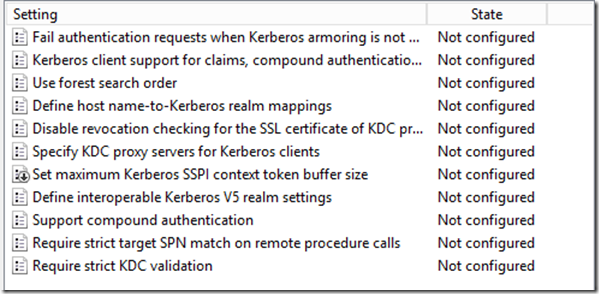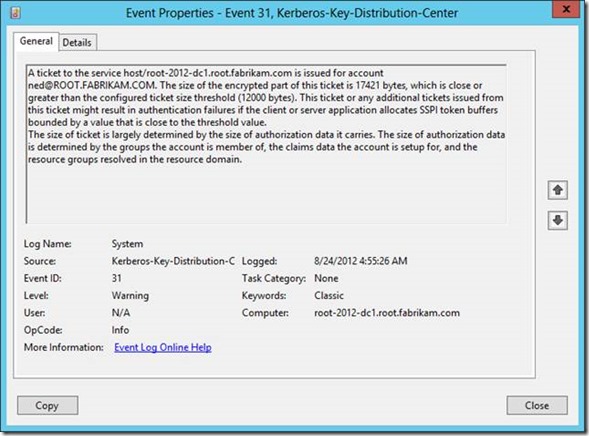MaxTokenSize and Windows 8 and Windows Server 2012
Hello AskDS Populous, Mike here and I want to share with you some of the excellent enhancements we accomplished in Windows 8 and Windows Server 2012 around MaxTokenSize. Let’s review MaxTokenSize and its symptoms before we jump in to wonderful world of Windows 8 (say that three times fast).
Wonderful World of Windows 8
Wonderful World of Windows 8
Wonderful World of Windows 8
What is MaxTokenSize
Kerberos is the default and preferred authentication protocol since the release of Windows 2000 Server. Over the last few years, Microsoft has made some significant investments in provided extensions to the protocol. One of those extensions to Kerberos is the Privilege Attribute Certificate or PAC (defined in Windows Server Protocol specification MS-PAC).
Microsoft created the PAC to encapsulate authorization related information in a manner consistent with RFC4120. The authorization information included in the PAC includes security identifiers, user profile information such as Full name, home directory, and bad password count. Security identifiers (SIDs) included in the PAC represent the user's current SID and any instances of SID history and security group memberships to the extent of current domain groups, resource domain groups, and universal groups.
Kerberos uses a buffer to store authorization information and reports this size to applications using Kerberos for authentication. MaxTokenSize is the size of buffer used to store authorization information. This buffer size is important because some protocols such as RPC and HTTP use it when they allocate memory for authentication. If the authorization data for a user attempting to authenticate is larger than the MaxTokenSize, then the authentication fails for that connection using that protocol. This explains why authentication failures resulted when authenticating to IIS but not when authenticating to folder shared on a file server. The default buffer size for Kerberos in Windows 7 and Windows Server 2008R2 is 12k.
Windows 8 and Windows Server 2012
Let's face the facts of today's IT environment… authentication and authorization is not getting easier; it's becoming more complex. In the world of single sign-on and user claims, the amount of authorization data is increasing. Increasing authorization data in an infrastructure that has already had its experiences with authentication failures because a user was a member of too many groups justifies some concern for the future. Fortunately, Windows 8 and Windows Server 2012 have features to help us take proactive measures to avoid the problem.
Default MaxTokenSize
Windows 8 and Windows Server 2012 benefit from an increased MaxTokenSize of 48k. Therefore, when HTTP relies on the MaxTokenSize value as the value used for memory allocation; it will allocate 48k of memory for the authentication buffer, which hold a substantially more authorization information than in previous versions of Windows where the default MaxTokenSize was only 12k.
Group Policy settings
Windows 8 and Windows Server 2012 introduce two new computer-based policy settings that help combat against large service tickets, which is the cause of the MaxTokenSize dilemma. The first of these policy settings is not exactly new-- it has been in Windows for years, but only as a registry value. Use the policy setting Set maximum Kerberos SSPI context token buffer size to change the MaxTokenSize using group policy. Looking closely at this policy setting in the Group Policy Management Editor, you'll notice the icon for this setting is slightly different from the others around it.
This difference is attributed to registry location the policy setting modifies when enabled or disabled. This registry setting is the actual MaxTokenSize registry key and value name that has been used in earlier versions of Windows
HKEY_LOCAL_MACHINE\SYSTEM\CurrentControlSet\Control\Lsa\Kerberos\Parameters\MaxTokenSize
Therefore, you can use this computer-based policy setting to manage Windows 8, Windows Server 2012, and earlier versions of Windows. The catch here is that this registry location is not a managed policy location. Managed policy locations are removed and reapplied during policy refreshes to avoid persistent settings in the registry after the settings in a Group Policy object become out of scope. That behavior does not occur with this key, as the setting applied by this policy setting is not removed during application. Therefore, the policy setting persists even if the Group Policy object providing the setting falls out of scope.
The second policy setting is very cool and answers the question that customers always asked when they encounter a problem with MaxTokenSize: "How big is the token? " You might be one of those people that went on the crusade of a lifetime using TOKENSZ.EXE and spent countless hours trying to determine the optimal MaxTokenSize for your environment. Those days are gone.
A new KDC policy settings Warning events for large Kerberos tickets provides you with a way to monitor the size of Kerberos tickets issued by KDCs. When you enable this policy setting, you then must configure a ticket threshold size. The KDC uses the ticket threshold size to determine if it should write a warning event to the system event log. If the KDC issues a ticket that exceeds the ticket threshold size, then it writes a warning. This policy setting, when enabled, defaults to the 12k, which is the default MaxTokenSize of previous version of Windows.
Ideally, if you use this policy setting, then you'd likely want to set the ticket threshold value to approximately 1k less than your current MaxTokenSize. You want it lower than your current MaxTokenSize (unless you are using 12k, that is the minimum value) so you can use the warning events as a proactive measure to avoid an authentication failure due to an incorrectly sized buffer. Setting the threshold too low will just train you to ignore the Event 31 warnings because they'll become noise in the event log. Setting it too high and you're likely to be blindsided with authentication failures rather than warning events.
Earlier I said that this policy setting solves your problems with fumbling with TOKENSZ and other utilities to determine MaxTokenSize-- here's how. If you examine the details of the Kerberos-Key-Distribution-Center Warning event ID 31, you'll notice that it gives you all the information you need to determine the optimal MaxTokenSize in your environment. In the following example, the user Ned is a member of over 1000 groups (he's very popular and a big deal on the Internet). When I attempt to log on Ned using the RUNAS command, I generated an Event ID 31. The event description provides you with the service principal name, the user principal name, the size of the ticket requested and the size of the threshold. This enables you to aggregate all the event 31s and identify the maximum ticket size requested. Armed with this information, you can set the optimal MaxTokenSize for your environment.
KDC Resource SID Compression
Kerberos authentication inserts security identifiers (SIDs) of the security principal, SID history, all the groups to which the user is a member including universal groups and groups from the resource domain. Security principals with too many group memberships greatly affect the size of the authentication data. Sometimes the authentication data is larger than the allocated size reported by Kerberos to applications. This can causes authentication failure in some applications. SIDs from the resource domain share the same domain portion of the SID, these SIDs can be compressed by only providing the resource domain SID once for all SIDs in the resource domain.
Windows Server 2012 KDCs help reduce the size of the PAC by taking advantage of resource SID compression. By default, a Windows Server 2012 KDC will always compress resource SIDs. To compress resource SIDs, the KDC stores SID of the resource domain to which the target resource is a member. Then, it inserts only the RID portion of each resource SID into the ResourceGroupIds portion of the authentication data.
Resource SID Compression reduces the size of each stored instance of a resource SID because the domain SID is stored once rather than with each instance. Without resource SID Compression, the KDC inserts all the SIDs added by the resource domain in the Extra-SID portion of the PAC structure, which is a list of SIDs. [MS-KILE]
Interoperability
Other Kerberos implementations may not understand resource group compression and therefore are not compatible. In these scenarios, you may need to disable resource group compression to allow the Windows Server 2012 KDC to interoperate with the third-party Kerberos implementation.
Resource SID compression is on by default; however, you can disable it. You disable resource SID compression on a Windows Server 2012 KDC using the DisableResourceGroupsFields registry value under the HKLM\Software\Microsoft\Windows\CurrentVersion\Policies\System\Kdc\Parameters registry key. This registry value has a DWORD registry value type. You completely disable resource SID compression when you set the registry value to 1. The KDC reads this configuration when building a service ticket. With the bit enabled, the KDC does not use resource SID compression when building the service ticket.
Wrap up
There's the skinny on the Kerberos enhancements included in Windows 8 and Windows Server 2012 that specifically target large service ticket and MaxTokenSize scenarios. To summarize:
· Increased default MaxTokenSize from 12k to 48k
· New Group Policy setting to centrally manage MaxTokenSize
· New Group Policy setting to write warnings to the system event log when a service ticket exceeds a designated threshold
· New Resource SID compression to reduce the storage size of SIDs from the resource domain
Keep an eye out for more Windows 8 and Kerberos needful
Mike "~Mike" Stephens
Comments
Anonymous
September 12, 2012
Nice improvements. Is reboot or just KDC service restart (without taking the DC off completely) needed after disabling the Resource SID compression in the registry?Anonymous
September 12, 2012
This is really cool thing. It's sad there is not path to make this also available for older Windows :)Anonymous
September 13, 2012
KDC should not require a reboot for these policy settings.Anonymous
September 17, 2012
Very glad this has finally been addressed. Thank you for sharing this information!Anonymous
September 19, 2012
Great writeup! Do older clients(e.g. Win7/Vista/XP) know how to handle the resource SID compression? Thanks ChristianAnonymous
September 21, 2012
Hi Christian, I had to run this down because I lost it in my notes. Resource SID compression algorithms go back to Windows 2000. However, Windows Server 2012 is the first KDC that will actually issue a ticket with resource SID compression enabled. Great Question -Mike Stephens



